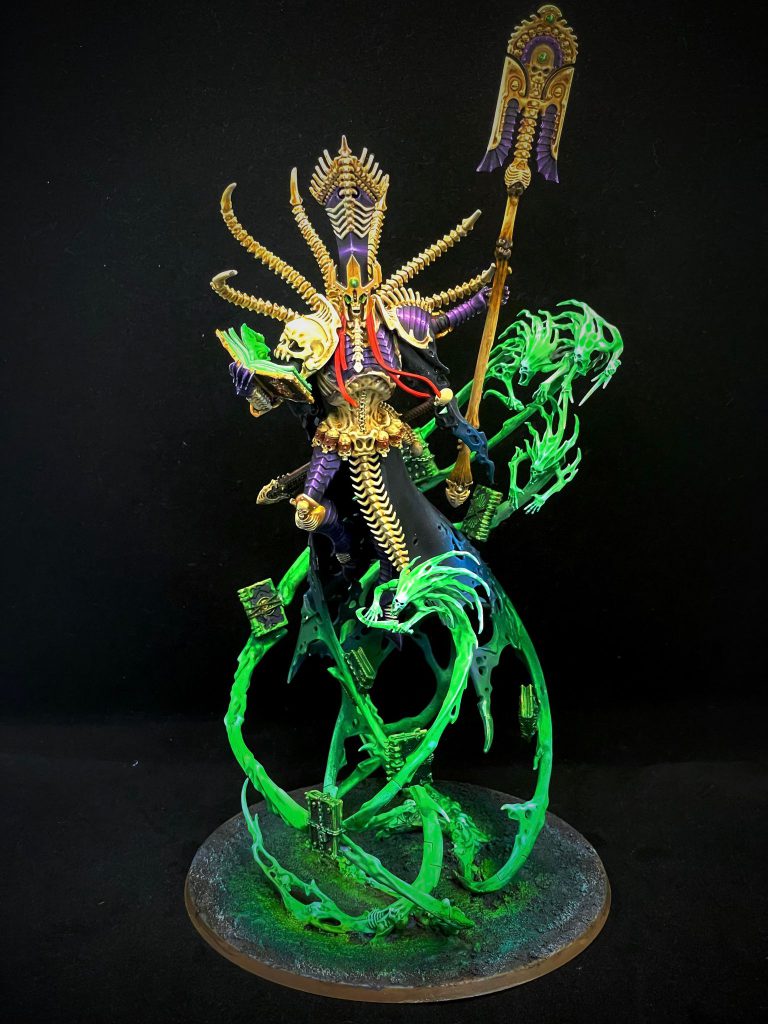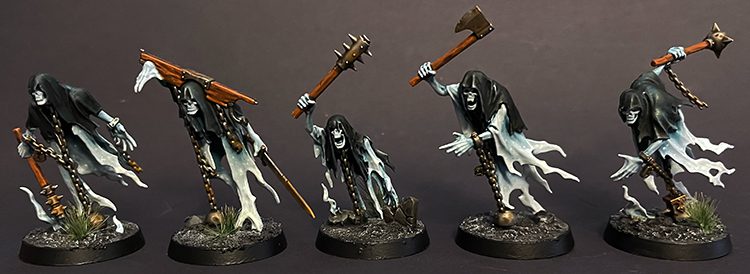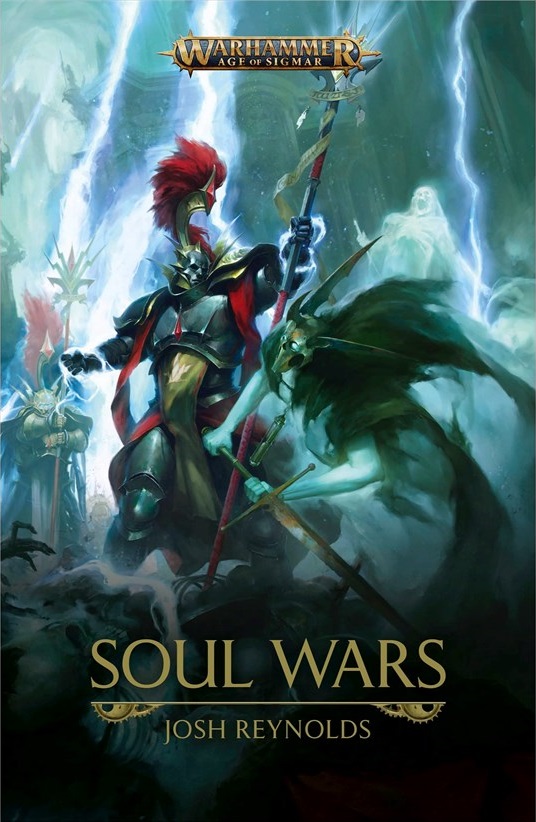I hate to repeat myself, but the name Josh Reynolds on the front cover of an AOS book can be used as a form of quality assurance. If you want to submerge yourself in the Mortal Realms and have the whole Age of Sigmar setting come to life (or unlife, in this case) then you can do a lot worse than picking up a Josh Reynolds novel. Soul Wars is a great book.
Nagash is a patient god. Being the god of death, he’s not exactly in any kind of rush; Death is as long term a commitment as you can get. Nagash can wait an age before enacting his plans. So, when he does decide to make his move, it matters. Soul Wars starts with the Necroquake, which is probably the most impactful event that has happened in Age of Sigmar lore since the start.

Over the course of centuries, Nagash has been gathering magical realmstone from the corners of his realm, and bringing it to the centre, to Nagashazar, his capital city. Here, he uses it to construct a giant, inverted pyramid.
The description of a Deathrattle Skeleton gathering the stone is one of the more haunting and enduring images of the book; relentlessly marching ceaselessly back and forth across the baron extremes of the realm, for miles and miles, and years and years, to the edges of the realm and back again, doing its master’s will.
Once the pyramid is constructed, it comes time for Nagash to enact his plan. He enters the pyramid and begins his rite of death, which will blast the realms with death energy, ending all life and replacing it with undeath; ushering in the age of death, with Nagash as supreme leader of all.
But there is something wrong. The Chaos gods show up and gloat at Nagash in the very moment he should be raising in dominance over them. Nagash discorporates, and his spirit speeds through the pyramid trying to find out what is happening. There he finds a small infestation of skaven, vandalizing and befouling his precious pyramid.
The spell is still cast, but only partially. Whilst it doesn’t succeed in its goal of wiping all life from the realms, it does batter them with rampant death magic, resurrecting scores of the undead, especially Nighthaunt. It also destabilizes magic forever.
Soul Wars then goes on to focus specifically on the city of Gymsforge, in Shyish, the realm of death, and the Stormcast Eternals who are tasked with defending it from a massive undead invasion.
As you’d expect, the novel offers a great insight into the way Death works. You get to spend a bit of time with Nagash, but you also get to see some of the internal politicking between his three favourite mortarchs; Arkhan, Neferata and Mannfred Von Carstein. Arkhan, Nagash’s most loyal lieutenant, even gives us a bit of intrigue in this story. Usually we see him as Nagash’s unswerving and unwavering companion, completely devoted to his master’s will, but in this book we begin to see that even he has ambitions that are his own.
Most interestingly, though, is the insight into the Nighthaunt army as it marches towards war. Instead of some sort of wave of tortured groaning souls, you begin to see the ghosts displaying unique characters. We’re not exactly talking deep and intricate nuanced personalities, but that’s sort of the point – these are recycled souls trying to cling on to something of their former selves.
Nagash has no interest in a diverse workforce brimming with ideas and creativity; he wants mindless automatons — basically, he’s a slightly less evil Jeff Bezos. Nagash views each of his followers as a mere extension of himself. All are Nagash and Nagash is all. The book is called Soul Wars and, yes, we see souls raising and going to war – but we also see individuals warring within themselves for their own souls. You see this among the Nighthaunt and within the mortarchs, however, most pointedly, you also see it within the Stormcast Eternals.
In particular, we see this war for the soul happening within Lord-Castelant Pharus Thaum as he fights to resist Nagash’s corrupting influence. When the necroquake disrupts the reforging process, Thaum’s soul manages to escaped before it can be reforged. Nagash gets a hold of it. There’s a great scene where we see Nagash toying with the soul as he inspects it, before handing it over to Arkhan to be shaped into a loyal servant.
As Nagash’s magic seeks to break Thaum down, he struggles throughout the book to retain his individuality, but can’t help but watch as his humanity begins to slowly slip away. However, most interestingly, this is not a new struggle for him. As a Stormcast Eternal, endlessly on the fight> die> reforge> repeat cycle, he was used to feeling himself slipping away due to too many turns on the Anvil of Apotheosis .
Soul Wars does a great job of wrestling with the toll of reforging, whereby each soldier becomes less human with each resurrection. We see the big villain, Nagash, trying to erase the individuality of his soldiers, and it’s horrifying – but golden boy Sigmar is, effectively, doing exactly the same thing. I’m not generally a big fan of books with Stormcast protagonists, but Soul Wars does a good job of making them seem more human, as they wrestle with the gravity and horror of what the reforging process costs them.
The stakes are much higher in this book. Most wars are fought over resources of some kind – land, water, oil, power – but this war is fought over souls. YOU are the resources both sides want, and not just your body, or your labour, or your allegiance, but your very soul, that little drop of eternity that you possess, that piece of essence that is most uniquely you. There are no higher stakes than that! And whereas death usually grants a cease to violence and destruction, a release from the horrors of war, for the followers of both Nagash and Sigmar it only marks the beginning.
![]()
If there was a moment that will stick with me the most it would be the little glimpse we get behind the curtain at Sigmar himself. Sigmar shows up in books from time to time to issue orders or give his people pep talks, but we see a vulnerability to him here. Nagash has managed to get to him, even here in Azyr. Sigmar’s safe space has been breached, His Anvil of Apotheosis has been damaged by the Necroquake, but, above all, it causes Sigmar to think back over his stormy past with Nagash.
They were once brothers, and then Nagash betrayed Sigmar (of course, Nagash would see Sigmar as the great betrayer and thief) and now they are locked in this great soul war, fighting over souls like kids over a toy. It’s a really compelling sub-plot that runs throughout the whole of AOS lore, but really comes to the fore in this book.
Having said that, a few weeks have passed since I’ve read the book now, and I don’t think any of the other characters, other than that glimpse of Sigmar, have really made an impression on me. They’re basically tropes; the studious and serious Lord-Arcanum, Balthas, and Elya, the intrepid urchin. They don’t really shine as fleshed out, 3D characters. I’ve probably thought about that skeleton marching up and down gathering realmstone more than any of the others.

Indeed, the main soul war that goes on throughout the book is for the soul of the book itself. It’s a good book, and a really enjoyable read, and was possibly the first AOS book to really get a good handle on the issues surrounding reforging, but there was something lacking in it. It’s got all the right ingredients; great battle scenes, interesting twists, characters with potential, great sentence-level writing, but I couldn’t help but feel the author was on autopilot – like that skeleton. There isn’t much deviation from the formula.
Don’t get me wrong, it’s a great formula, but it’s hard to find that intangible something all great books have that you just can’t quite put your finger on; that magic and spark; that soul! There were times when I found myself skimming through to get to the next bit. Perhaps all it needed was a stricter edit to remove all the superfluous bits of gumpf.
Soul Wars is most certainly essential AOS reading. It covers an important period of history in the Mortal Realms, and gives a really clear insight into some of the central themes. I’m really glad I read it, and I’m telling you that you should really go and read it too, I’m just not sure I’d ever go back and read it again.
Have any questions or feedback? Drop us a note in the comments below or email us at contact@goonhammer.com. Want articles like this linked in your inbox every Monday morning? Sign up for our newsletter. And don’t forget that you can support us on Patreon for backer rewards like early video content, Administratum access, an ad-free experience on our website and more.


